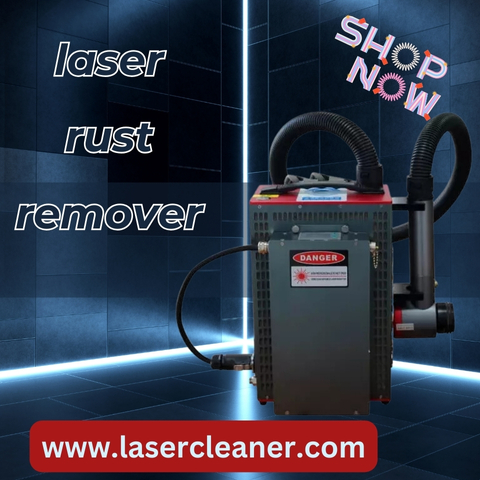
Rust is a common problem for many surfaces exposed to moisture, particularly in environments where metals, machinery, and vehicles are prevalent. For years, individuals and industries have relied on various methods to remove rust, including abrasive tools, chemicals, and even traditional sanding. However, with the advancement of technology, one of the most efficient and precise methods available today is the laser rust remover.
How Does a Laser Rust Remover Work?
A laser rust remover is an innovative tool that uses laser technology to effectively clean metal surfaces. It operates on the principle of focused light energy, which is directed precisely onto the rusted surface, causing the rust to break apart and be removed without damaging the underlying metal. The process begins with a high-powered laser that emits short pulses of light, which are absorbed by the rust but not by the base material underneath.
When the laser beam hits the rust, the rust molecules absorb the energy, causing them to heat up rapidly. This intense heat causes the rust to loosen and disintegrate. In many cases, the rust particles are vaporized, leaving the metal clean and undamaged. This laser-based method is highly controlled and precise, allowing for meticulous cleaning without impacting the structural integrity of the underlying metal.
One of the significant aspects of laser rust removal is the use of light to perform the cleaning. Since the rust absorbs the laser energy more effectively than the metal surface, the rust is targeted without affecting the metal itself. This allows for high precision and minimal collateral damage. The laser does not require any harsh chemicals or abrasive materials, making it an environmentally friendly solution.
How Does Laser Rust Removal Compare to Other Methods?
In comparison to traditional rust removal methods, such as mechanical scraping, sandblasting, or chemical treatments, the laser rust remover provides several advantages in terms of precision and cleanliness.
-
No Chemicals or Abrasives: Unlike chemical treatments or abrasive blasting, which can create hazardous waste or damage the surface, the laser rust removal process uses no chemicals and creates no debris. This makes the process much cleaner and safer for both the operator and the environment.
-
Precision Cleaning: Traditional methods often remove rust by scraping or blasting, which can also damage the surface of the metal, especially if the metal is delicate or thin. A laser, on the other hand, can be focused with pinpoint accuracy, meaning only the rust is removed, leaving the metal surface intact.
-
Minimal Wear on Equipment: Since there is no abrasive element involved in the laser cleaning process, the wear on both the equipment and the material being cleaned is minimal. This means that the machine will last longer, and the treated metal will not suffer from unnecessary wear and tear.
-
Efficient and Fast: The laser rust remover is capable of removing rust at a much faster rate than traditional methods. The precision and power of the laser allow for rapid cleaning, which can be a significant time saver, particularly for industries that need to maintain large quantities of machinery or vehicle parts.
How to Use a Laser Rust Remover?
Using a laser rust remover is relatively simple and can be done by individuals with minimal training. The device typically consists of a handheld unit with a laser emitter and controls to adjust the intensity of the laser. Here’s a general process for how to use it effectively:
-
Preparation: Before beginning the rust removal process, ensure that the surface is clean of any large debris or loose dirt. This will help the laser focus more effectively on the rust.
-
Set the Parameters: Depending on the model, you may be able to adjust the intensity and focus of the laser. It is essential to set these parameters correctly to ensure that the rust is removed efficiently without damaging the surface.
-
Direct the Laser: Aim the laser at the rusted area. The laser should be moved across the surface in a sweeping motion, ensuring that the entire rusted area is treated. Some systems may have automatic systems to ensure even coverage.
-
Observe the Process: As the laser works, you will see the rust begin to disintegrate or evaporate. The cleaner the surface underneath, the less time it will take for the rust to be completely removed.
-
Finish the Job: After the rust has been removed, inspect the surface to ensure that no residue is left. In most cases, no further cleaning is required, but if necessary, the metal can be lightly cleaned to remove any remaining particles.
Is Laser Rust Removal Suitable for All Types of Metals?
One of the most attractive features of laser rust removers is their versatility. These machines can be used on a wide range of metals, including steel, aluminum, and copper. However, it’s important to consider the type of metal you are working with before using a laser rust remover. The surface of certain metals may react differently to the laser’s heat, and certain alloys may require more delicate handling.
For example, while laser rust removal is highly effective on steel, it may require special settings for more sensitive metals like aluminum. In these cases, operators may need to adjust the laser’s power and intensity to prevent damage to the base material.
Applications of Laser Rust Removal
The laser rust remover is used in various industries and applications. Its versatility and precision make it suitable for:
-
Automotive Industry: Vehicle parts, machinery, and tools are frequently exposed to rust. Laser rust removal provides a precise and efficient way to restore these items to their original state, especially when delicate parts are involved.
-
Aerospace Industry: Aircraft components require a high level of precision. The ability to remove rust without damaging the underlying material makes laser rust removal perfect for cleaning intricate and sensitive aerospace parts.
-
Marine Industry: Ships and boats that operate in harsh environments often suffer from rust and corrosion. Laser rust removal allows for effective cleaning of these surfaces without causing damage to the underlying material.
-
Manufacturing and Industrial Equipment: Equipment and machinery in factories can accumulate rust over time, leading to malfunctions or even breakdowns. Laser cleaning ensures that rust is removed quickly and efficiently, ensuring the longevity of these expensive machines.
-
Metal Restoration: Antique or old metal items, such as sculptures, tools, or vintage vehicles, may accumulate rust over time. Using a laser rust remover ensures that the metal is cleaned without altering the original structure or finish, preserving its value.
Final Thoughts
The laser rust remover represents a significant leap forward in rust removal technology. By harnessing the power of focused laser light, it offers a precise, efficient, and environmentally friendly solution to one of the most common problems in industries and households alike. Whether you’re restoring antique tools, cleaning machinery, or maintaining vehicles, laser rust removal is an effective and sustainable choice that delivers exceptional results.



